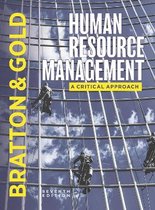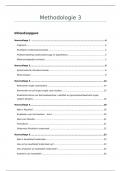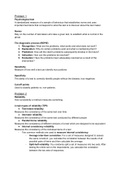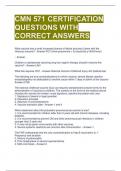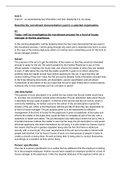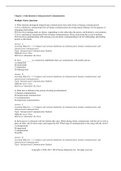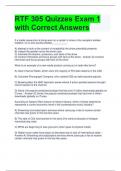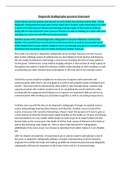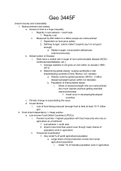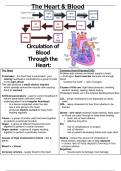Bratton, J,. Gold, J., Bratton,. A & Steele, L. (2022)
Chapters: 1,2,3,4,5,6,7,10,11
Chapter 1: Contemporary Human resource Management.
HRM is concerned with managing work and the employment relationship. There
are significant differences between the two approaches to managing workers.
The first two British definitions describe what the function of personnel
management ideally should be. Analysing the statements, some common values
and themes emerge. Evidently, personnel management is about ‘working
relationship’ and ensuring the ‘agreement is fulfilled’. The selective definitions
perceive personnel management as occupying a neutral position, placed between
the employer and the workers, and engaged in processes aiming to provide fair
terms and conditions as well as having a responsibility to provide satisfying work.
The role is also described as the ‘humane bureaucrat’ and ‘consensus
negotiator’.
Selective HRM definitions. Past and present
Past: personnel management is a series of activities which: first enable working
people and their employing organizations to agree about the objectives and
nature of their working relationship and, secondly, ensuring that the agreement
is fulfilled. (1989)
Present: HRM then is the process through which management builds the
workforce and tries to create the human performances that the organization
needs. (2016)
Hard and soft HRM
The soft HRM approach h emphasis the ‘H’ and purports to place a high value on
people as a creative asset and source of competitive advantage, and treats
workers holistically, with attention to development, job satisfaction an well-being.
Soft HRM is generally likened tot the Harvard Model.
The hard approach puts the emphasis on the ‘R’. its leitmotiv is minimising costs
and profit maximisation and it views the worker as an atomised ‘resource’. Hard
HRM is associated with the Michigan model.
These divergent approaches have been identified as ‘utilitarian-instrumentalism’
and ‘developmental humanism’ models of HRM.
At a theoretical level, Boxell et al. advance the notion of ‘analytical HRM’ to
emphasize that the primary task of HRM scholars is to build theory and gather
empirical data in order to identify and explain ‘the way management actually
behaves in organizing work and managing people. This approach to
conceptualizing HRM has thee interrelated analytical themes. First it is concerned
with the ‘what’ and ‘why’ of HRM, that is, with understanding human behavior in
different contexts and with explaining motives. Second, it is concerned with the
‘how’ of HRM, that is, the processes by which it is carried out. In this context,
Blau’s (1964) influential concept of social exchange theory (SET) is often referred
to. SET emphasizes instrumental human behavior. People, it is said, will feel a
sense of obligation to reciprocate when they perceive that they are being treated
well by their employer (Gilbert et al., 2011a).The ‘what’, ‘why’ and ‘how’ of HRM
is likely to vary over time and space. Context is a crucial factor in explaining how
employers manage their workers. Through the political economy perspective of
‘varieties
,Human resource management is a strategic approach to managing work and
employment relations. It underscores that leveraging people’s capabilities,
commitment and cooperation is a prerequisite for realising desired goals. This is
accomplished through a distinctive set of integrated employment practices and a
positive employment relationship, embedded in an organisational, societal and
ecological context.
Three important emphases can be identified in our definition as to what HRM
aspires to be. First, HRM is considered as having a ‘strategic’ role and hence it
represents a confluence of both strategic management and HR management
activities, so that the way work and jobs are designed, and effective worker
management, contributes to desired strategic ‘goals’. Second, and related, the
primacy of people – only the ‘human factor’ has the inherent capacity to
generate value. By their nature, other variables, such as technology, have inert
potential that can only be leveraged by some human being.
With this in mind, any adequate analytical conception of HRM should draw
attention to the notion of indeterminacy: workers have a potential capacity to
provide the added value desired by the employer. This emphasises that people
are not passive inputs, but capable of potential agency and development.
The third area of focus in our definition is on the importance of the integration of
the HR system with the organisation’s goals. Recent HRM and leadership
research have focused more on the arguments and evidence that effective
people management is associated with higher worker well-being and a positive
relationship (Carter et al., 2013; Guest, 2017; Peccie et al., 2013). A high work-
related well-being is associated with physical and mental health and dignity at
work. A positive employment relationship is signified by high levels of trust, a
perception of fairness, security and mutual respect
The employment relationship
Workers and capitalists enter into an employment relation or contract. The
contract is characterised by two fundamental features: first, workers exchange
their capacity to work, their ‘labour power’, as an object that is distinct from the
person themself, and second, that capacity is regulated into uniform temporal
units – hours, days,night shifts – using cash (see Edgell and Granter, 2020).
Employment relationships vary: at one end of the scale, they can be a short-term,
primarily but not exclusively economic exchange for a relatively well-defined set
of duties and low commitment; at the other, they can be complex long-term
relationships defined by a broad range of economic inducements and relative
security of employment, given in return for a broad set of duties and a high
commitment
from the worker.
What, then, is the essence of the employment relationship? The literature
identifies four key dimensions of the employment relationship: economic, social,
legal and psychological. The first dimension of the employment relationship is
that it incorporates an economic relationship: the ‘exchange of pay for work’
(Brown, 1988). This ‘exchange’ is characterised by five other essential and
interrelated features. First, product market conditions directly affect the
employer’s revenue, with potential changes to the terms and conditions of
employment. Second, capitalism is subject to economic forces, particularly those
attached to product markets and profit-making, which involves continuous
change and restructuring and, periodically, economic crises and recessions (Fine,
1998).
,Third, and related, the state influences the economic relationship indirectly
through fiscal and monetary policies which determine aggregate expenditure,
investment, consumer spending and the general ‘character’ of the employer
behaviour towards employment relations (Edwards, 2003b). Further the state
effects the economic exchange directly through employment law on wages (for
example, the statutory minimum wage). Fourth, the exchange is dependent upon
a process of abstracting value in which work or effort level is indeterminate.
Thus, the employer buys a potential level of physical or intellectual labour. When
people enter into a work-wage bargain it places an obligation on both the
employer and the worker: in exchange for a pay. The worker’s time is not his
own; it belongs to the employer who buys it. Insofar as a worker is working they
are obligated to perform an amount of physical, intellectual or emotional labour.
For the nineteenth-century historian Thomas Carlyle and philosopher Karl Marx,
the phrase ‘cash nexus’ encapsulated the depersonalised nature of exchange
between the employer and the worker. In customer-facing occupations found in
tourism, hospitality and retail,
‘work’ or effort also includes workers’ feelings and appearances, as well as the
way they behave, so that as well as productive work there is ‘emotional’ and
‘aesthetic labour’.
Fifth, the work-wage bargain is structurally conflictual. In classical capitalism the
‘wage’ side of the bargain generates tension and conflict because wages are a
cost to the employer, which affects profitability. As Brown (1988, p. 57) observes,
‘Conflict is structured into employment relations’ as wages or salaries to workers
is a cost to the employer. The ‘work’ side of the contract also generates
pressures and conflict because it is, as noted, the employer who buys a worker’s
time and the worker’s labour
power is inherently indeterminate. The function of management is, therefore, to
transform this potential into actual value-added labour. HR practices are
designed to narrow the divide between workers’ potential and actual
performance or, in Townley’s (1994, p. 14) words: Personnel practices … offer a
technology which aims to render individuals and their behaviour predictable and
calculable … to bridge the gap between promise and
performance, between labour power and labour, and organizes labour into a
productive
force or power.
The second dimension of the employment relationship is that it incorporates
social relations unique to a capitalist society. Workers and managers are not
isolated individuals but members of a family, community and social groups, such
as a trade union or professional association, who observe social norms and mores
that influence their actions in the workplace. Wage rates and jobs are not exactly
like other prices and quantities. They are much more involved in the way people
see themselves, think about their social status, and evaluate whether they are
getting a fair shake out of society. … Buyers and sellers of labour might not
accede to perceived injustice merely because of a little excess supply or demand.
For Solow, pay and jobs are tied to social status, perceived self-identity, self-
worth and social justice. A thorough interrogation of the social domain draws
attention to the role of power in explaining the dynamics of the employment
relationship. For unless the worker happens to be an international football
celebrity, the employment relationship embodies an uneven balance of power
between the parties. The dominant perspective defines power as the capacity or
the potential to influence others in relation to their beliefs, attitudes or activities.
This perspective is often associated with the well-known concept of social power
, (French and Raven, 1960). Through this theoretical prism, coercive, reward and
legitimate power are predicated on a person’s position in the formal hierarchy of
the organisation. Warren (1969) argues that the most important source of power
is coercion and reward. Coercive power is the primary force that keeps
subordinates from retaliating when faced with abusive behaviour by a line
manager (Lian et al., 2014). In contrast, subordinates comply because a manager
can distribute rewards. An employer promising you a pay increase or promotion
to act as she or he instructs is using reward power. Reward power is a function of
dependence. The greater is worker B’s dependence on manager A, the more
power A has over B. Critical scholars, on the other hand, contend that power is
not simply something the powerful have and the powerless lack. Power is
exercised through work organisations and society. Power is everywhere and
comes from everywhere.’ In Foucault’s analysis, power is exercised many ways –
‘economies of power’, ‘networks of power’ and ‘technologies of power’ (Crane et
al., 2008).
The third dimension of the employment relationship is that it involves a legal
relationship: a network of contractual and statutory rights and obligations
affecting both parties to the contract. Contractual rights are based upon case law
(judicial precedent), and the basic rules of contract, insofar as they relate to the
contract of employment, are fundamental to the legal relationship between the
employer and the worker. It is outside the scope of this chapter to provide a
discussion of the rules of contract.
A fourth, less tangible dimension of the employment relationship is the
psychological contract. The ‘psychological contract’ is a metaphor that captures a
wide variety of largely unwritten expectations and understandings of the two
parties about their mutual obligations. Guest and Conway (2002, p. 22) define it
as ‘the perceptions of both parties to the employment relationship – organization
and individual– of the reciprocal promises and obligations implied in that
relationship’. At the heart of the concept of the psychological contract are levers
for individual motivation (M) and task performance (O) beyond the ‘expected
outcomes’. The psychological contract has important features that managers
need to appreciate. First, HR practices may communicate different beliefs about
the reciprocal promises and obligations that are present (Guest and Conway,
2002). Workers will have different perceptions of their psychological contract,
even when the legal contract is identical. Managers will therefore be faced with a
multitude of perceived psychological contracts (PPCs) within the same
organisation (Bendal et al., 1998). A psychological contract breach (PCB) can
affect both worker performance and retention.
Although the PPC thesis offers important insights into the employment
relationship, it does have major weaknesses. Godard (2014) is critical that the
field of HRM has become increasingly dominatedby psychological theorising: the
‘psychologisation’ of HRM. The essence of the PPC thesis is the idea that a
workforce is a collection of atomised individuals, as though individual beliefs are
fixed features of a worker’s day-to-day behaviour. In doing this, in total contrast
to critical paradigms, PPC neglects a
well-established body of research grounded in sociology showing that people’s
beliefs and expectations about employment form outside the workplace. The idea
that family members and peers can influence expectations about work and
career opportunities is called ‘orientation to work’ (Bratton, 2021). The central
importance of work and the four key dimensions of the employment relationship
–economic, social, legal and psychological – means that the field of HRM needs to


